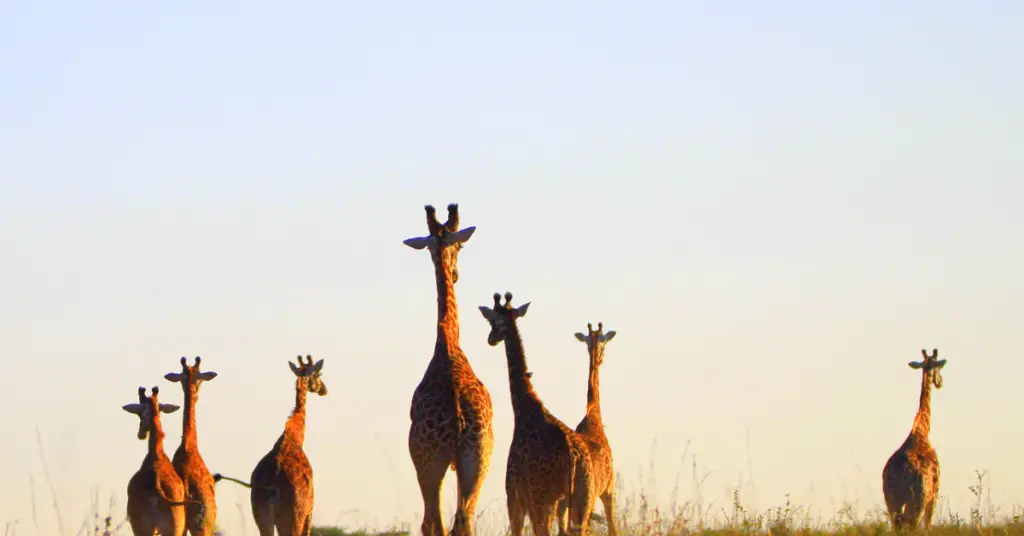The herd of giraffes is called a tower.
Cows and subadults form breeding herds of 425 individuals, and although large herds may exist, they are rare. A herd of 239 was recorded in the Serengeti and herds of 48 and 68 in the Kruger National Park.
A herd is defined as a group in which all individuals maintain direct eye contact with each other and moving at the same pace, in the same direction for simultaneous purposes such as walking, drinking, or avoiding danger. Herds are not stable and constantly change in size and composition.
The giraffe has no fixed family bond and individuals are exchanged between adjacent herds at social gatherings. Herds have no dominance hierarchy.The radical displacement of mass herds is only temporary and allows the exchange of individuals and the restructuring of farms.
Adult bulls are solitary nomads. They associate with different breeding herds for a short duration, mostly for mating and the testing the oestrus of females. Sub-adult bulls form small bachelor herds of 2-5 individuals until the age of eight when social maturity is reached and they become adult nomads.
Giraffes are sociable, unstable, and highly variable, comprising any combination of sex and age classes at any given time and rarely made up of the same individuals for an indefinite period. The average size of the herd is varied, often between 2 – 6 and 8, depending on population density and food availability: Katavi N. P. (Tanzania), 3.6, Luangwa Valley,3.6, NW. Namibia, 3.88, and Niger,6.9. Maximum herd size also varies between populations 13 to 47, although up to 240 individuals have been observed in a herd.
Males tend to be solitary or associate in bachelor herds, becoming increasingly solitary as they mature, and often wandering between herds monitoring the reproductive status of females. Giraffes are not territorial but occupy spaces of varying sizes depending on sexage group, competition, forage and resource availability.
The mean home range sizes of males and females were very similar (164 km2 and 162 km2, respectively). Seasonal home ranges were exclusive to Niger, where their average size during the dry season (90. 7 km2) was twice as large as that during the wet season(46.6 km2).
Other mean annual home-range sizes recorded for adult females (using the minimum convex polygon method) were 41 km2 in Timbavati Private N. R., South Africa, 68 km2 in the Luangwa Valley, 200 km2 in northern Namibia, 285 km2 in Kruger N. P., South Africa and 367 km2 in Niger. The home range recorded for males was 82 km2 in the Luangwa Valley and 842 km2 in Niger.
The longest range of linear motion measured in other populations was 86 km in the Luangwa Valley, 70 km in N. Namibia, and 50 km in Tsavo East N. P. The average daily linear movements of two adult bulls (fitted with a GPS satellite collar) in northern Namibia ranged between 4.3 and 7.5 km.
Serious fights are rare, but when observed they have been brief and violent; saw a bull concussed during one such fight, whereupon the fallen animal was hammered with both head and hooves while lying prostrate. He also reported a case in which a bull passed out and took 20 minutes to recover.
Females often leave the herd to give birth. Calves are born while the cow is still standing with its hind legs slightly bent to reduce the fall which, at a height of two meters, causes the umbilical cord to break. Calves may stand within half an hour.
It is observed that a giraffe made no attempt to eat the placenta after childbirth. However they are very connected to their calves and it is described that the mother showed intense interest in the calf carcass for weeks, no doubt indicative of the mother-calf bond. Neonates are hidden for a few weeks and thereafter form nursery groups only in populations where food and water resources are far of the place of birth (mothers and children remain closely related for 14 to 22 months, until the time of the next birth.
Young calves are playful and peaceful, but frequent ‘necking’occurs between subadult males. Vocal folds and laryngeal ventricles are entirely absent, supportingthe view that Giraffes are mute. However, they rarely emit various loud sounds, especially under stressful conditions. They can grunt, snort, cough, and whistle, and the calves bleat, though what such vocalizations communicate remains undetermined. Captive Giraffes emit infrasonic vocalizations around or below 20 Hz.
The maximum lifespan of male Giraffes, based on individuals in Luangwa Valley, is shorter approx. 22 years compared with females that live up to 28 years; maximum longevity in captivity is recorded at 39 years.

Erzsebet Frey (Eli Frey) is an ecologist and online entrepreneur with a Master of Science in Ecology from the University of Belgrade. Originally from Serbia, she has lived in Sri Lanka since 2017. Eli has worked internationally in countries like Oman, Brazil, Germany, and Sri Lanka. In 2018, she expanded into SEO and blogging, completing courses from UC Davis and Edinburgh. Eli has founded multiple websites focused on biology, ecology, environmental science, sustainable and simple living, and outdoor activities. She enjoys creating nature and simple living videos on YouTube and participates in speleology, diving, and hiking.
🌿 Explore the Wild Side!
Discover eBooks, guides, templates and stylish wildlife-themed T-shirts, notebooks, scrunchies, bandanas, and tote bags. Perfect for nature lovers and wildlife enthusiasts!
Visit My Shop →
